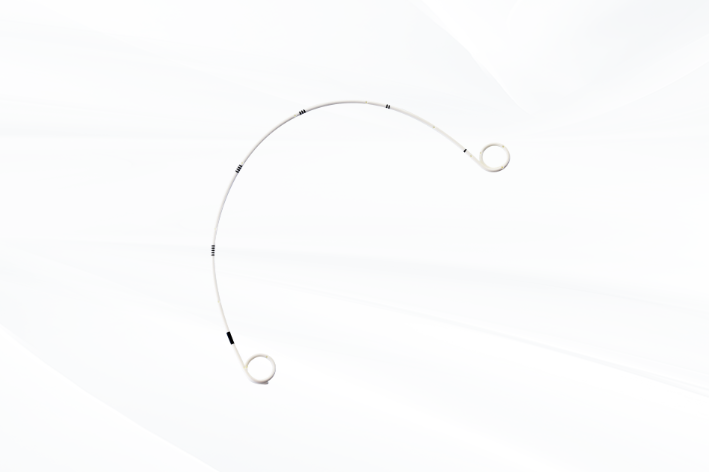Ureteral stent, also called ureteric stent or double-J ureteral stent, is a thin, flexible tube inserted into the ureter to facilitate urine drainage. This device is commonly used when normal urine flow is obstructed to ensure proper urinary system function.
The design of the stent takes patient comfort into consideration. Its coils securely anchor the stent in the kidneys and bladder to prevent displacement. Clinical and anatomical factors determine which size of stent medical professionals will select for each patient. During long-term use, the monitoring process must check for signs of ureteral stent infection as well as displacement.

Ureteral stents are widely used to prevent blockages caused by stones or their fragments after lithotripsy or other treatments.
Any condition causing a blockage, including scar tissue, congenital abnormalities, or benign strictures, can necessitate a stent placement.
Pelvic tumors block or compress the ureter, impairing renal function. A metallic ureteric stent can bypass malignant strictures and preserve kidney function under high external compression.
Radical cystectomy with ureteroenteric anastomosis may benefit from temporary internal drainage. An appropriate ureteral stent stabilizes the anastomosis and decreases postoperative leaking.
Chronic strictures develop from fibrosis, ischemic injury, or prior instrumentation. In such cases, a long-term indwelling ureteral stent can maintain lumen patency and avoid repeat open revision.
Vesicouterine or ureterovaginal fistulas complicate pelvic surgeries and radiation therapy. A ureteral stent seals minor leaks and supports tissue healing without the need for open surgical repair.
Healthcare professionals insert a rigid or flexible cystoscope through the urethra into the bladder. A guidewire is then passed through the cystoscope into the obstructed ureter. Imaging tests, such as fluoroscopy or a kidney ultrasound, help locate the site of obstruction and guide the whole surgical procedure. The ureteral stent is then placed over the guidewire. The coiled end of the ureteral stent sits in the kidney, while the looped part rests in the bladder. Finally, the other instruments are removed, leaving only the stent in place.
After the procedure, patients often experience slight flank pain with blood in their urine, which both fade shortly. The symptoms from the stent disappear shortly after placement, although the device will remain inside the patient for a period determined by the patient's clinical needs.
In general, most patients have their stents removed within a few days to a few weeks, depending on their condition. More advanced materials and coatings designs can provide a marginally extended dwelling period by preventing mineral buildup. In cases requiring long-term use, such as ureteral strictures or tumor-related compression, stents may need replacement every three to six months. Replacing the stent reduces complications like urinary tract infections (UTIs).
Patients with malignant obstructions can have metal-based products in their bodies for twelve months. They must get regular scans to check for early signs of complications. If a ureteral stent stays beyond its recommended time, it can cause serious blockages. This makes retrieval harder and may require laser fragmentation to break up hardened deposits. Routine imaging and urine tests help determine the optimal timing for replacement or removal, ensuring proper kidney function and minimizing risks.
The removal procedure is performed under local anesthesia or light sedation with cystoscopic guidance. Medical professionals insert a cystoscope through the urethra and into the bladder to locate the distal coil of the ureteral stent. A micro clip or forceps on the cystoscope grasp and retract it while monitoring for any mucosal trauma or resistance due to calcification or encrustation. The bladder is filled with an irrigant for better visualization, and the withdrawal is done steadily to prevent stent kinking or coil migration.
Trigonal irritation, bladder spasms, and stent friction create discomfort that produces flank or suprapubic pain and urinary urgency, as well as hematuria. Some patients may also experience a pulling sensation during urination. Signs of infection include fever, chills, and foul-smelling urine. If there's ongoing flank tenderness, it needs broad-spectrum antibiotics and regular urine cultures.
Patients can reduce urinary frequency by using the alpha-blocker Tamsulosin to relax smooth muscles. NSAIDs can also help with pain relief. However, not everyone is suitable for NSAIDs. So, it is best to consult a healthcare provider. Proper hydration, regular stent surveillance, and maintaining a well-balanced urine pH help prevent complications. Recovery after stenting or its removal takes about one to two weeks. Symptoms improve after the stent is taken out.
The selection of appropriate ureteral stents determines patient recovery results. Well Lead Medical produces double J ureteral stents from high-grade medical materials. They provide enhanced biocompatibility, patient comfort, and reduced encrustation risks.
The stent's pigtail construction stops it from moving inside the body, and its smooth surface allows for easier insertion and removal. The thin-wall construction maximizes drainage efficiency, and enhanced radiopacity ensures clear imaging visibility for precise placement. Well Lead Medical offers various designs, coatings, diameters, and lengths to meet different clinical needs. For detailed specifications, please contact us!